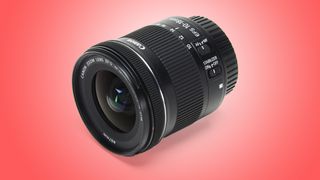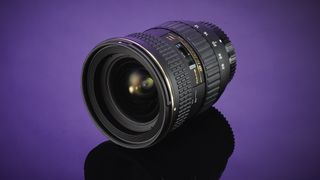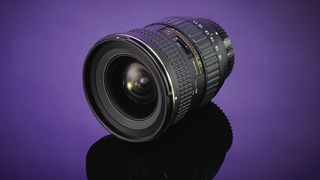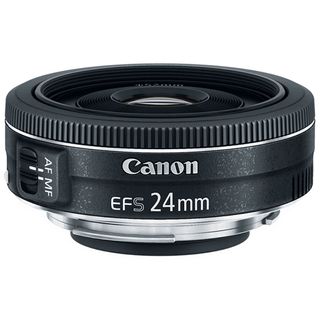The best wide-angle lenses for Canon DSLRs in October 2019
Get the more in your pictures with these super-wide optics
Canon's entry-level and enthusiast cameras, right up to the EOS 7D Mark II, use an APS-C size sensor. This means you need wide-angle lenses designed specifically for this smaller sensor size and this is what we list here. Just bear in mind that you can't use these lenses on full-frame cameras if you decide to upgrade later on.

1. Sigma 10-20mm f/3.5 EX DC HSM for Canon
Specifications
Reasons to buy
Reasons to avoid
This lens is newer, bigger and better than Sigma's original 10-20mm, which is still on sale. This new one has a constant f/3.5 maximum aperture, yet it's now only a little more expensive than its predecessor.
It's a professional-grade lens with fast and quiet ring-type ultrasonic autofocus and a seven-blade diaphragm. It's quite a chunky lens, though, and features a large 82mm filter thread. Sharpness and contrast are excellent and it's also very consistent throughout the zoom range. Colour fringing is very well controlled, and distortion is only really noticeable towards the shortest end of the zoom range. In all, it's a superb lens that's also great value for money.

2. Sigma 8-16mm f/4.5-5.6 DC HSM for Canon
Specifications
Reasons to buy
Reasons to avoid
The Sigma 10-20mm f/3.5 (top) is a bit of a modern classic because of its specs, performance and price, but if you want a lens that's wider still, then take a look at this Sigma 8-16mm. It only has a 2x zoom range, but at these focal lengths the extra 2mm at the wide-angle end of the zoom range makes a big difference to the angle of view.
The Sigma 8-16mm is quite long because the hood is built into the lens barrel, but the build quality is very good, with a smooth-acting zoom ring and ring-type ultrasonic autofocus system.
One downside of the ultra-wide angle of view is that barrel distortion at the short end of the zoom range is more noticeable but this lens is unbeatable if you're after the widest possible view.

3. Canon EF-S 10-18mm f/4.5-5.6 IS STM
Specifications
Reasons to buy
Reasons to avoid
Canon is rolling out more and more compact, lightweight lenses with its STM (stepping motor) autofocus system. The lightweight theme stretches to the mounting plate, unfortunately, which is made from plastic rather than metal. But the STM system delivers silent and fairly rapid autofocus, along with smooth autofocus transitions – very important when shooting video.
The 'fly by wire' focus ring is very thin, which isn't great for handling, but it's very smooth and precise in operation. The 10-18mm zoom range makes sense, as it gives a wide angle of view at the short end, and matches the 18mm starting point of standard kit zooms at the long end.
Another bonus is that this lens offers image stabilisation, which is uncommon in super-wide-angle lenses. Sharpness is good and this lens outperforms Canon's long-established 10-22mm lens at some settings, despite costing a lot less.

4. Tokina AT-X Pro 12-28mm f/4 DX for Canon
Specifications
Reasons to buy
Reasons to avoid
With a minimum focal length of 12mm, this Tokina lens can't go quite as 'wide' as most of its rivals, but it does offer a longer maximum zoom setting which makes it more of an all-rounder that you could leave on the camera more of the time. It feels reassuringly robust and has Tokina's new SD-M (Silent Drive-Module) autofocus, which is based on a GMR (Giant Magneto Resistance) system.
It still lacks full-time manual override, but you can quickly switch between AF and MF via a simple control in the focus ring. The amount of barrel distortion is disappointing at the shortest zoom setting, but it's practically non-existent at the long end of the zoom range.
Sharpness is respectable, but it isn't quite as good as Tokina's own 11-16mm lens (below).

5. Tokina AT-X Pro 11-16mm f/2.8 DX II for Canon
Specifications
Reasons to buy
Reasons to avoid
With its comparatively paltry 1.45x zoom range, both the minimum and maximum focal lengths offered by this Tokina lens look unimpressive. But the spec that sets it apart from the rest is its f/2.8 widest aperture, which remains constant throughout the zoom range – it's the one of the 'fastest' super-wide-angle lenses on the market.
It's an update of an older model but the latest Mk II edition of the lens doesn't add much for Canon users, apart from revamped coatings to resist ghosting and flare. Sharpness is good throughout the zoom range, even at f/2.8, though colour fringing is a bit high and distortion levels are slightly disappointing.

6. Tamron SP AF 10-24mm f/3.5-4.5 DI II for Canon
Specifications
Reasons to buy
Reasons to avoid
When it was first launched, this Tamron lens set a new 2.4x zoom range record for a super-wide-angle lens. That's since been equalled by the Nikon 10-24mm, though, and the Tokina 12-28mm also comes close. The Tamron does have a built-in electric motor for autofocus but it lacks the refinement of ring-type ultrasonic or stepping-motor systems, and the focus ring rotates during autofocus so you have to keep your fingers clear.
Sharpness at the centre of the frame is good, especially at the short end of the zoom range, although the edges and corners of images can look soft. Barrel distortion remains quite pronounced throughout the zoom range.
The Tamron is still a decent buy, but the drop in price of the constant-aperture Sigma 10-20mm f/3.5 makes the Tamron look less of a bargain and in both specs and performance the Tamron 10-24mm now looks average.

7. Canon EF-S 10-22mm f/3.5-4.5 USM
Specifications
Reasons to buy
Reasons to avoid
For a long time this has been the official Canon super-wide-angle zoom for its APS-C DSLRs, and although it's now been joined by the new EF-S 10-18mm STM lens, the 10-22mm remains the pricier, more upmarket option.
Now 10 years old, the lens still feels like a quality item, and includes ring-type ultrasonic autofocus and a focus-distance scale mounted beneath a viewing window.
We have, however, experienced poor sharpness from this lens in the past. The sample we tested this time proved better at the frame centre with apertures around f/8, yet sharpness was still disappointing towards the edges and corners, especially at larger apertures, where vignetting was also noticeable.

8. Canon EF-S 24mm f/2.8 STM Lens
Specifications
Reasons to buy
Reasons to avoid
Let's end the list with something affordable, that is a great starting point for anyone looking for an easy to use wide-angle lens— the iconic Canon 24mm f/2.8 "pancake lens".
Being a prime lens, you lose the ability to change the focal length, but you can an additional stop of aperture for creamy out-of-focus backgrounds. 24mm is a good focal range for architecture, landscape and even product photography and has minimal barrel distortion too.
The newer variant with STM has a very quick and quiet autofocus motor, making it ideal for instances such as vlogging or videos too. Prime lenses are often recommended to beginners to better understand the nuances of photography, and the 24mm f/2.8 gets a strong recommendation at a starting price of under Rs 10,000.
Current page: Best wide-angle lens for Canon APS-C DSLRs
Prev Page Super-wide-angle zooms explained Next Page Best wide-angle lens for Canon full-frame DSLRsGet daily insight, inspiration and deals in your inbox
Get the hottest deals available in your inbox plus news, reviews, opinion, analysis and more from the TechRadar team.
Aakash is the engine that keeps TechRadar India running, using his experience and ideas to help consumers get to the right products via reviews, buying guides and explainers. Apart from phones, computers and cameras, he is obsessed with electric vehicles.
Most Popular


